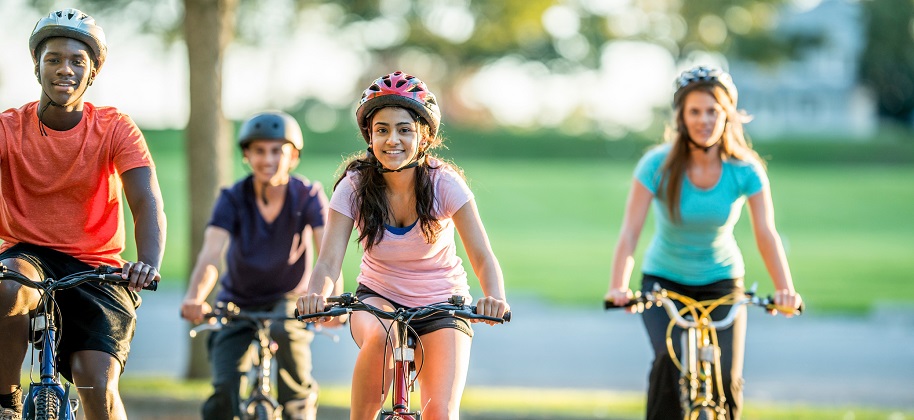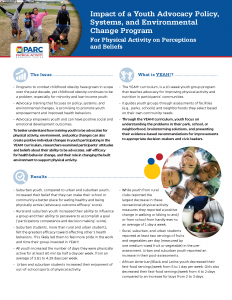Impact of a youth advocacy policy, systems and environmental change program for physical activity on perceptions and beliefs
By: Nisha D. Botchwey, Jasmine Jones-Bynes, Katie O’Connell, Rachel O’Connell, Anna J. Kim, and Terry L. Conway
The Issue
- Programs to combat childhood obesity have grown in scope over the past decade, yet childhood obesity continues to be a problem, especially for minority and low-income youth.
- Advocacy training that focuses on policy, systems, and environmental changes, is promising to promote youth empowerment and improved health behaviors.
- Advocacy empowers youth and can have positive social and emotional development outcomes.
- To better understand how training youth to be advocates for physical activity, environment, and policy changes can also create positive individual changes in youth participating in the YEAH! Curriculum, researchers examined participants’ attitudes and beliefs about their ability to be advocates, self-efficacy for health behavior change, and their role in changing the built environment to support physical activity.
What is YEAH!?
- The YEAH! curriculum, is a 10-week youth group program that teaches advocacy for improving physical activity and nutrition in participants’ communities.
- It guides youth groups through assessments of facilities (e.g., parks, schools) and neighborhoods they select based on their own community needs.
- Through the YEAH! curriculum, youth focus on understanding the problems in their park, school, or neighborhood, brainstorming solutions, and presenting their evidence-based recommendations for improvements to appropriate decision-makers and civic leaders.
Results
- Suburban youth, compared to urban and suburban youth, increased their belief that they can make their school or community a better place for eating healthy and being physically active (‘advocacy outcome efficacy’ score).
- Rural and suburban youth increased their ability to influence a group and their ability to persevere to accomplish a goal (‘participatory competence and decision making’ score).
- Suburban students, more than rural and urban students, felt the greatest efficacy toward affecting other’s health behaviors. This likely led them to feel more pride in the work and time their group invested in YEAH!
- All youth increased the number of days they were physically active for at least 60 min by half a day per week, from an average of 3.81 to 4.29 days per week.
- Urban and suburban students increased their enjoyment of out-of-school sports of physical activity.
- While youth from rural clubs reported the largest decrease in these recreational physical activity measures they reported a positive change in walking or biking to and/or from school from hardly ever to an average of 1 day a week.
- Rural, suburban, and urban students reported at least two servings of fruits and vegetables per day (measured by one medium-sized fruit or vegetable) in the preassessment. Urban and suburban youth reported an increase in their post-assessments.
- African American/Black and Latinx youth decreased their fast-food servings/week from 5 to 1 day per week. Girls also decreased their fast-food servings/week from 4 to 2 days compared to an increase for boys from 2 to 3 days.
Implications
- This research provides an opportunity to better understand the implementation of this advocacy training program to promote childhood obesity prevention outcomes and overall youth well-being.
- This study demonstrated numerous improvements in advocacy and health behavior outcomes among youth.
- Demonstrating greater confidence that YEAH! can help make their school and/or community a better place for being physically active or eating healthy.
- Students’ perceptions of ‘peer support for healthy behaviors’ increased and suburban students felt the most confident about the efficacy of their group to influence adults.
- These findings suggest that, in relation to urban students, suburban and rural students are more hopeful, optimistic, and have a greater belief in their own ability to influence change.
- Overall, these findings indicate a positive effect of the YEAH! program and youth advocacy for health behaviors.
Methodology
- Eighteen youth-serving organizations were recruited from low-income urban, suburban, and rural neighborhoods in California, Florida, Georgia, Hawaii, Maine, Maryland, Virginia, and Washington, DC.
- The sample used in this analysis included 137 middle school aged minority youth; 59 boys and 78 girls, and five race/ethnic groups—43 African American/Black, 19 Latino, 33 Asian American, Pacific Islander/ Native Hawaiian, 25 multiracial youth, and 17 non-identified.
- Based on the location of the YEAH! club, participants were also classified by ‘place’, urban (n=62), suburban (n=59) or rural (n=16) geographic areas.
- Students completed paper-based pre- and post-intervention surveys during the first and last YEAH! club sessions.
Findings from this lay summary are available in the full article, published in Preventive Medicine:
Botchwey, N., Jones-Bynes, J., OConnell, L.K., Millstein, R., Kim, A., Conway, T. (2020) Impact of a Youth Advocacy Policy, Systems and Environmental Change Program for Physical Activity on Perceptions and Beliefs. Preventive Medicine. 136. doi.org/10.1016/j.ypmed.2020.106077
Suggested Citation for Lay Summary:
Botchwey, N, et al. Impact of a Youth Advocacy Policy, Systems and Environmental Change Program for Physical Activity on Perceptions and Beliefs. A Lay Summary. San Diego, CA: Physical Activity Research Center and Atlanta, GA: Georgia Institute of Technology; 2021.
This lay summary was made possible with funding from the Physical Activity Research Center. The research that generated the lay summary was led by Drs. Nisha Botchwey and Anna Kim.

